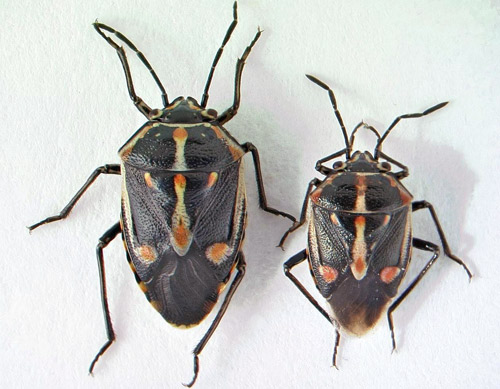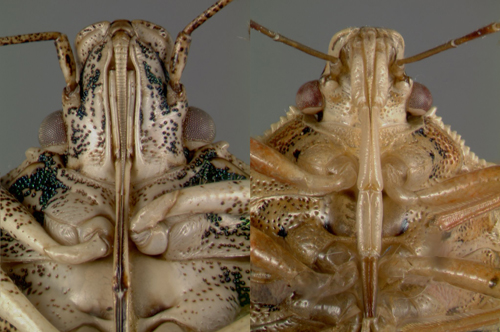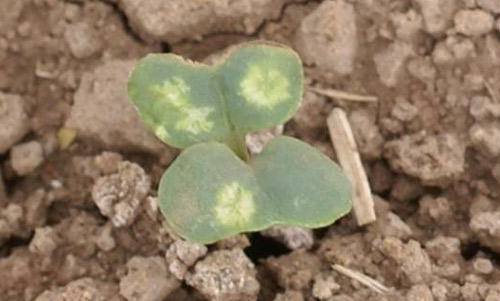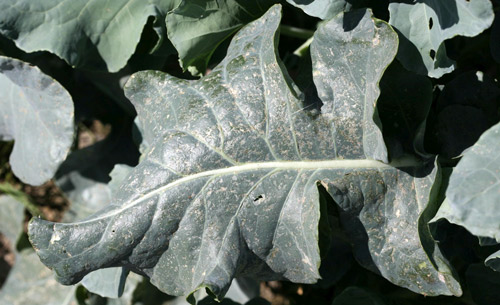common names: bagrada bug, painted bug (suggested common names)
scientific name: Bagrada hilaris (Burmeister)
(Insecta: Hemiptera: Pentatomidae)
Introduction - Synonymy - Distribution - Description - Host Plants - Similar Species - Damage - Management - Selected References
Introduction (Back to Top)
The bagrada bug, Bagrada hilaris (Burmeister), also known as the painted bug, is native to Africa. It was first reported in the United States in June of 2008 in the county of Los Angeles, California (Arkelian 2008). Bagrada hilaris may be confused with the similar looking harlequin bug, Murgantia histrionica (Hahn), which is widespread throughout the United States. It has also been confused with ladybird beetles (Family: Coccinellidae). The bagrada bug is a true bug in the order Hemiptera, and more specifically is a stink bug in the family Pentatomidae. It causes substantial damage to cruciferous crops such as broccoli, cabbage, mustards, and cauliflower, as well as infests a wide range of other crops and weeds species (Palumbo and Natwick 2010, Hill 1975). It has become a serious agricultural pest in the southwestern United States.
Figure 1. Dorsal view of Bagrada hilaris; adult female (left), and adult male (right). Photograph by, Gevork Arakelian, Los Angeles County Department of Agricultural Commissioner's Office.
Synonymy (Back to Top)
Bagrada cruciferarum Kirkaldy 1909
Bagrada picta Fabricius 1775
(Azim and Shafee 1986, Horvath 1936, Rebagliati et al. 2005)
Distribution (Back to Top)
Bagrada bugs are found throughout southern and eastern Africa, as well as southern Asia, and southern Europe (Hill 1975). In 2009, the bagrada bug began to move north along the coast of California, inland to the desert valleys, and continued west into southwestern Arizona (Palumbo and Natwick 2010). Bagrada bugs have since spread into southern Nevada, southern Utah, a few isolated counties in southern New Mexico, and western Texas (Palumbo and Natwick 2010, Bundy et al. 2012, Reed et al. 2013).
Bagrada bugs have been detected on plant material in trucks traveling across state borders. The bagrada bug is not currently known to be established in Florida; and significant interceptions by the Florida Department of Agriculture and Consumer Services (FDACS) agricultural inspection stations along the interstate at the Florida border have resulted in The Federally Recognized State Managed Phytosanitary Program Work Plan for Bagrada Bug Sponsored by the State of Florida. Monitoring, surveillance, quarantine research, and educational efforts in Florida continue to occur in order to facilitate the early detection and rapid response efforts associated with the bagrada bug.
Description (Back to Top)
Adults: The adult body is shield shaped, and ranges in size from 5-7 mm long, and 3-4 mm wide. Females are slightly larger than males. Bagrada bugs are approximately one eighth of the size of the harlequin bug, Murgantia histronica. The coloration of the adult is black with red and yellow markings, and is very similar to the harlequin bug; however, the harlequin bug has perpendicular markings, and the bagrada bug has markings predominantly running lengthwise. The pronotum (dorsal thoracic plate anteriorly positioned on the body) and the scutellum (central triangular plate on the dorsal surface of the thorax) of adult bagrada bugs both have an obvious longitudinal marking down the center.
Eggs: Oviposition typically occurs on the undersides of cotyledons, leaves, stems, and in the soil near the base of plants (Reed and Perring 2012, Palumbo and Natwick 2010). Eggs are commonly laid singly and close together. However, the eggs may be laid in nearly linear clusters consisting of approximately 10 eggs. Each adult female can produce over 100 eggs during a season (Hill 1975). Eggs have an opaque, white to light red hue, and nymphs emerge after approximately 3 to 4 days during optimal temperature conditions (Reed and Perring 2012). In laboratory studies, the eggs begin to appear pink within 2-3 days and can incubate after 3 days at 35.8°C (96°F), and as long as 6 days at 25.6°C (78°F) (Singh and Malik 1993).
Figure 2. Life stages of the bagrada bug. Photographs by Surendra Dara, University of California Cooperative Extension (first three nymphal stages, and adult); Eric Natwick, University of California Cooperative Extension (eggs and fourth nymphal stage).
Nymphs: Bagrada bugs have five nymphal stages (Singh and Malik 1993). Newly emerged first instars are bright red and have a slightly darkened to black coloration on the pronotum, head, legs, and antennae; the abdomen remains reddish and develops some black bands and white dots as the early nymphal stages advance. The bodies of late instars are darker and may still have pale to dark red markings. Similar to other plant-feeding stink bugs, the first instar nymph will remain on or near the egg it emerged from and does not feed until after molting into a second instar.
Figure 3. Bagrada hilaris adults and nymphs on alyssum. Photograph by Gevork Arakelian, Los Angeles County Agriculture Commissioner's Office.
Biology (Back to Top)
Bagrada bugs become a major pest during the cole crop growing season of the spring and fall when favorable environmental conditions and food sources allow the bugs to proliferate. Multiple overlapping generations occur during the height of the cole crop production season in the fall and spring. Adult activity tends to peak during the warmer parts of the day when the temperatures are above 25°C and below 41°C (Reed et al. 2013).When the temperatures are outside of that range (above 41°C or below 25°C), bagrada bugs will seek shelter near the soil surface (Reed et al. 2013).
Aggregation behavior is observed in bagrada bugs as hundreds of nymphs and adults can be found in clumped distributions in the field (Reed et al. 2013). When plowed or threshed fields lack adequate plant material, bagrada bugs will seek green vegetation around the field (Singh and Malik 1993). Adults are capable of overwintering in areas with cruciferous weeds such as wild mustards and London rocket; though extreme summer temperatures reduce the population of bagrada bugs, adults may survive the summer and cause severe damage to germinating crops in the early fall (Reed et al. 2013).
Host Plants (Back to Top)
The principal host plants of the bagrada bug are cruciferous crops including broccoli, cauliflower, cabbage, kale, turnip, radish, chard, mustard, arugula, rutabaga, collard greens, bok choy, napa, and broccoflower. However, other plants and crops can become infested as well, including Bermuda grass, sorghum, sudan grass, potato, canola, cotton, corn, sunflowers, papaya, capers, cantaloupe, pearl millet, sugar cane, and wheat (Hill 1975, Gupta and Gupta 1970, Singh and Malik 1993). Legumes such as snap peas, green beans, and mung beans may become infested. Bagrada bugs can be found aggregating and attempting to feed on many other plants that are non-hosts (Reed et al. 2013).
In the absence of the preferred cruciferous crops, adults will feed on weeds occurring in and around fields. (Reed et al. 2013, Singh and Malik 1993). Bagrada bugs will feed on weedy plants, including shortpod mustard, London rocket, shepard’s purse, sweet alyssum, vetch, lambsquarter, Indian mustard, pill-pod spurge, wild jujube, corn-sow thistle, nut sedge, and field bindweed (Reed et al. 2012, Singh and Malik 1993).
Similar Species (Back to Top)
The bagrada bug is a pest of concern to Florida agriculture, and there are several similar species with which it may be confused. Early and late instars of the bagrada bug may resemble many other stink bugs. Therefore, sample submissions from within the state of Florida may be made to the University of Florida Insect Identification Lab. Please refer to the guidelines for sample submission before sending any samples.
The harlequin bug, Murgantia histrionica (Hahn), is similar to the bagrada bug in coloration, and is also a pest of cruciferous crops. The notable size difference (the harlequin bug is much larger) between the two species will help distinguish between adults of the bagrada bug and the harlequin bug.
Ladybird beetles (Family: Coccinellidae) are similar in appearance due to the coloration of the adults. The body of the adult ladybird beetle is also noticeably wider and rounder than the bagrada bug.
Two small stink bugs native to Florida may be confused with the bagrada bug. Mormidea pama and Mormidea lugens are similar in size to the bagrada bug; however, the adults of both of these species lack red markings on the back, and are found primarily on grass species.
The early nymphs of two predatory stink bugs found in Florida, the spined soldier bug (Podisus maculiventris), and the Florida predatory stink bug (Euthyrhynchus floridanus), closely resemble the nymphs of bagrada bugs. These two predatory stink bugs should be fairly easily distinguished from the bagrada bug because the predatory stink bugs are larger, and have a stout and robust rostrum as opposed to the long, slender rostrum associated with herbivorous stink bugs.
Figure 4. Species similar in appearance to the bagrada bug, Bagrada hilaris. From left to right: Harmonia axyridis, Bagrada hilaris, Mormidea pama, and Murgantia histronica. Photograph by Lyle Buss, University of Florida.
Figure 5. Comparison of the mouthparts of a plant feeding stink bug versus a predatory stink bug. On the left is a plant feeding stink bug, Halyomorpha halys,with a long and slender beak. On the right is a predatory stink bug, Podisus maculiventris, with a stout and robust beak. Photograph by Lyle Buss, University of Florida.
Damage (Back to Top)
Typical of plant feeding stink bugs, bagrada bugs cause physical damage through piercing-sucking mouthparts. The cotyledon stage of direct-seeded plants in the field is the most susceptible stage to feeding damage; however, a high preference for the four-leaf-stage of broccoli plants has been observed in laboratory trials (Huang et al. 2014b). Short periods of infestation during the early stage of plant development results in loss of total leaf area and a reduction in chlorophyll content, which may be part of a feeding-induced stress response (Huang et al. 2014a). The insects feed on both surfaces of the leaves, and presumably inject saliva to aid in breaking down the inner leaf tissue (Palumbo and Natwick 2010).
Figure 6. Bagrada hilaris feeding damage on cotyledons of broccoli seedling. Photograph by John Palumbo, University of Arizona.
Figure 7. Bagrada hilaris feeding damage on two-leaf-stage broccoli plant. Photograph by John Palumbo, University of Arizona.
Figure 8. Feeding damage on broccoli leaves by Bagrada hilaris. Photograph by Gevork Arakelian, Los Angeles County Agriculture Commissioner’s Office.
Damage to cotyledons of direct-seeded plants results in visible white patches, wilting, desiccation, and scorching of the feeding areas (Reed and Perring 2012). Similar damage is observed when feeding occurs on young and old leaves. Transplanted seedlings are severely damaged by feeding on the apical meristem. Apical meristems and growing points die as a result of feeding, which leads to unmarketable crops of leafy crucifers like broccoli, cabbage, and cauliflower (Palumbo and Natwick 2010). Damaged apical meristems may result in adventitious bug break, stunting, and development of small unmarketable heads at the lateral parts of the plant. Crops including broccoli, cauliflower, and head cabbage may not produce any heads at all due to the damage, a condition known by farmers as "blind" plants.
Figure 9. Bagrada hilaris feeding damage resulting in unmarketable broccoli plant with small multiple crowns. Photograph by John Palumbo, University of Arizona.
Figure 10. Bagrada hilaris feeding damage resulting in “blind” cauliflower plants. Photograph by John Palumbo, University of Arizona.
Management (Back to Top)
Crucifer Pests:
Insect management for crucifer crops is an important and relevant area for Florida agriculture. It is not yet known if current pest management practices in Florida’s crucifer crop production will provide adequate control of bagrada bugs; however, extensive information on crucifer insect pest management is available.
Monitoring:
Early detection is crucial due to the ability of bagrada bug populations to rapidly increase. Monitoring should begin before planting by scouting and inspecting areas around the field intended for production. Sweep netting and careful visual observation of the soil surface, weeds, grasses, and other vegetation surrounding the field are essential to determine if bagrada bugs are present. Fields surrounded by weedy areas with an abundance of wild mustards or other host plants may be at a higher risk for bagrada bug infestation. Regularly inspect all plants in the field, as well as all plant shipments coming in or going out of the operation. Collect and observe bagrada bugs during the day, taking care not to disturb the plants so that the bugs will not drop to the soil surface or fly away. Black light trapping is not effective; however, visual observation at night with a fluorescent lamp is effective (Huang et al. 2012). Scouting should coincide with peak activity occurring during the warm parts of the day to improve accuracy of field sampling.
Action threshold levels are defined as the levels of pest population at which control should be implemented to avoid significant crop damage. The action threshold levels for the bagrada bug are not yet established; however, based on preliminary field trials, plant damage and crop losses were reduced when contact insecticides were applied when populations exceeded one adult per three row feet of seedlings or transplants (Reed et al. 2013).
Chemical control:
Young seedlings are the most susceptible to feeding damage, and should be protected by insecticides if a field has a history of bagrada bugs. Contact foliar insecticides applications are the most effective during the afternoon and early evening during the height of insect activity on plants (Chauhan and Yadav 2007, Huang et al. 2012); however, because bagrada bugs fly away when disturbed, adults can easily escape before contact with the insecticide and return later (Reed et al. 2012). Additionally, bagrada bugs may drop to the soil to avoid contact with insecticides. Field trials in India demonstrated that sowing imidacloprid-treated seed provided higher productivity and reduced plant damage (Ahuja et al. 2008). Further bio-efficacy evaluations in India and in Arizona demonstrated positive results using pyrethroids, pyrethrins, neonicotinoids, and organophosphate insecticides to control bagrada bugs and increase yields (Singh et al. 2011, Reed et al. 2012).
Cultural control:
Weed suppression and removal of crop residues after harvest in and around fields during the growing season and the overwintering season may help reduce sources of infestation (Palumbo and Natwick 2010, Reed and Perring 2012). Seedlings and transplants for crucifer production may be isolated in protected greenhouses to exclude bagrada bugs during the most vulnerable stages of plant development (Reed and Perring 2012). Planting clean, non-infested transplants from nursery stock is critical to reduce the spread and potential outbreaks of bagrada bug populations. Screened tunnels, floating row covers, and fine mesh screening material can be used to cover and protect field plantings. Burying the edges of the protective covers will help prevent bagrada bugs from reaching the plants.
Biological control:
Research is proceeding to assess efficacy of entomopathogenic fungi against the bagrada bug. Beauveria bassiana, Metarhizium anisopliae, and Paecilomyces fumosoroseus are examples of entomopathogenic fungi that attack different types of insects, and are being evaluated for use against the bagrada bug.
Natural enemies: Generalist predators including spiders may attack bagrada bugs. Parasitoids that attack the eggs of bagrada bug include flies (Families: Sarcophagidae and Tachinidae) and wasps (Family: Scelionidae). However, there are no known natural enemies in the U.S.A. that specifically prey on them (Reed and Perring 2012). The ability of the bagrada bug to rapidly increase population size is one of the challenges to finding effective biological controls.
Selected References (Back to Top)
- Ahuja R, Singh SK, Sundria MM, Dhandapani A. 2008. Integrated management strategy for painted bug, Bagrada hilaris (Burm.) inflicting injury at seedling stage of mustard (Brassica juncea) in arid western Rajasthan. Pesticide Research Journal 20: 48-51.
- Azim MN, Shafee SA. 1986. The life cycle of Bagrada picta (Fabricius) (Hemiptera: Pentatomidae). Articulata 8: 261-265. (23 May 2014)
- Bundy CS, Grasswitz TR, Sutherland C. 2012. First report of the invasive stink bug Bagrada hilaris (Burmeister)(Heteroptera: Pentatomidae) from New Mexico, with notes on its biology. Southwestern Entomologist 37: 411-414.
- Chauhan R, Yadav JL. 2007. Bioefficacy and persistence of some insecticides against painted bug, Bagrada hilaris (Burn.). Agricultural Science Digest 27: 71-72.
- Gupta JC, Gupta DS. 1970. Note on some new hosts of the painted-bug (Bagrada cruciferarum Kirk.: Pentatomidae, Heteroptera). Indian Journal of Agricultural Sciences 40: 645-646.
- Hill D. 1975. Agricultural insect pests of the tropics and their control, 1st Ed. Cambridge University Press, Cambridge, UK.
- Hodges G. 2014. Personal communication. Florida Department of Agriculture and Consumer Services, Division of Plant Industry.
- Hoenisch R, Burkle CJ, Hodges AC. 2013. Bagrada bug (Bagrada hilaris). University of California, Davis, and University of Florida. (24 March 2014)
- Horvath G. 1936. Monographia pentatomidarum Generis Bagrada. Annales Musei Nationalis Hungarici 30: 22-47. (23 May 2014)
- Huang TI, Reed DA, Perring TM, Palumbo JC. 2014a. Feeding damage by Bagrada hilaris (Hemiptera: Pentatomidae) and impact on growth and chlorophyll content of Brassicaceous plant species. Arthropod-Plant Interactions, 1-12.
- Huang TI, Reed DA, Perring TM, Palumbo JC. 2014b. Host selection behavior of Bagrada hilaris (Hemiptera: Pentatomidae) on commercial cruciferous host plants. Crop Protection 59: 7-13.
- Palumbo JC, Natwick ET. 2010. The bagrada bug (Hemiptera: Pentatomidae): A new invasive pest of cole crops in Arizona and California. Plant Health Progress. doi:10.1094/PHP-2010-0621-01-BR.
- Patidar J, Patidar RK, Shakywar RC, Pathak M. 2013. Host preference and survivability of Bagrada hilaris (Burmeister, 1835) on off season crops. Annual Plant Protection Science 21: 273-275.
- Rebagliati PJ, Mola LM, Papeschi, AG, Grazia J. 2005. Cytogenetic studies in Pentatomidae (Heteroptera): A review. Journal of zoological systematics and evolutionary research 43: 199-213.
- Reed DA, Newman JP, Perring TM, Bethke JA, Kabashima JN. 2012. Management of the bagrada bug in nurseries. Department of Entomology, University of California Riverside. (March 20 2014)
- Reed D, Palumbo JC, Perring TM, May C. 2013. Bagrada hilaris (Hemiptera:Pentatomidae), an invasive stink bug attacking cole crops in the southwestern United States. Journal of Integrated Pest Management. 4: C1-C7.
- Reed DA, Perring TM. 2012. Bagrada bug: Biology, host range and effects on cole crops. Center for Invasive Species Research. University of California, Riverside. (5 February 2014)
- Russell D. 2012. Agricultural interdiction station inspection (PowerPoint presentation). Florida Department of Agriculture and Consumer Services, Cooperative Agricultural Pest Survey. (25 March 2014)
- Singh H, Malik VS. 1993. Biology of painted bug. Indian Journal of Agricultural Science 63: 672-674.
- Singh SP, Singh YP, Arvind K. 2011. Bio-efficacy of chemical insecticides against painted bug, Bagrada hilaris (Burm.) in mustard. Pesticide Research Journal 23: 150-153.









